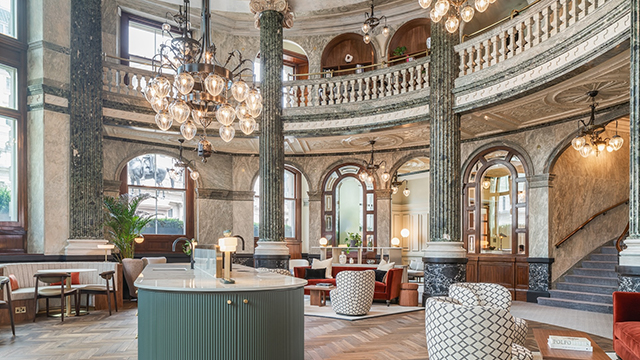The British are having a love affair with Italian food. Pizza Hut is about to open its 500th restaurant in the UK and the more upmarket PizzaExpress now has around 300 restaurants. These are just two of the biggest chains. Jostling for space on the high street are the likes of Ask Central Ð which saw its pre-tax profits increase by 29% in the first six months this year Ð and Strada to name but two.
Given this evidence it is clear the Italian offer goes down so well with diners in this country, but can a slightly more sophisticated style of restaurant become as prolific? Or indeed how do they succeed?
When it comes to pizza and pasta, Shelley Sandzers Nicholas Weir says that the likes of ASK Central and PizzaExpress have got their product right. James Alexander, managing director of Locum Destination Consultancy agrees: Time and money are the key issues.
A report by FPDSavills highlights that these brands actively target a particular segment of the market. For example, Pizza Hut has cornered the family market seeing off competition from the likes of Pizzaland and Deep Pan Pizza. It locates in areas where there are large volumes of people such as on leisure schemes near cinemas.
At the next level up PizzaExpresss successful formula of slightly more upmarket food and surroundings is being replicated by other operators on the high street. Deep-pan has been replaced by wood-fired ovens in order to attract the middle market, who are willing to pay more for the dining experience.
Aside from pizza/pasta groups the number of chains catering for the middle market diminishes rapidly. Indeed, it is this sector that has to a certain extent taken a battering during the last 12 months with the likes of Fish! having to sell outlets and Chez Gerard pruning its restaurant numbers to buoy profits.
Yet some of these restaurants offer up similar basic fare, so surely the middle market palate can stretch from posh pizza to fish or steak and chips? Mark Cutler of Knight Frank believes it comes down to price. Pizza/pasta is simple food, but so is steak and chips; a lot of it is attitude towards price, he comments.
Customers have realised they want value for money and the pizza/pasta, Belgo/Stradas [type of restaurant] provides this, says Cutler.
Donaldsons Tim Westlake-Bryant agrees. Using the branch of Fish! in Leeds as an example, he asks: Who in Leeds is going to pay £10.95 for fish and chips?
It is something that Groupe Chez Gerard has recognised, announcing in July that it is to cut the cost of dining by providing cheaper options on the menu.
Focus shift
The Hartford Group, which numbers the Pharmacy, London, among its restaurants, announced in the spring that it was shifting its focus from fine dining to bars with food operations. The Group bought the 17-strong Jamies Bar group this year.
Hartnell Taylor Cooks Neil Perrin points out the customer base for middle market restaurants is smaller because they are aimed at people with a higher disposable income and, therefore, this limits the number of restaurants an operator can open. But it is not just about money. The customers dining at these restaurants are looking for a different experience to that which you would get at one of the more upmarket chains.
The likes of Chez Gerard is the next rung up the ladder [from pizza chains] where you get into the business marketÉit is not so much about cost its about the experience, says Alexander. At a posh restaurant you are going to remember every moment of the experience.
Davis Coffer Lyons Trevor Watson believes there is a changing perception and maturing attitude towards heavily-branded restaurants. Certainly the backlash towards branded pub chains would bear this out.
If you are looking for an aspirational dining experience you will be brand adverse, he comments.
Cutler shares the same view. He points out that there has been a change in attitudes with people looking for individuality in their dining experience. Being a one-off is becoming far more important for the middle market than the safe, tried and tested formula that has made the pizza/pasta restaurant chains so successful. Adam Ratzker of Shelley Sandzer comments: A common argument is that to replicate the so-called high-end concept would detract from the whole exclusivity of it, and therefore it may be important to vary each restaurant under the same group whilst concentrating on good design and quality food.
Alexander agrees pointing out that customers at this level want a changing menu and environment and the moment a restaurant concept becomes prolific then it has lost something.
It is a formula that seems to have worked for the Conran Group. There are currently 19 different restaurants excluding the Zinc Bar & Grill concept, all of which have different names and offer varying types and styles of cuisine. Apart from branching out into other major cities such as Paris and New York, the Conran Group has only chosen to take its Zinc format outside the capital. Shelley Sandzers Weir says it is interesting that the group has chosen to roll out this concept as it has what he describes as a much more palatable price point compared to the other Conran restaurants. There are five Zinc Bars around the UK.
Individual strength
The Red Pepper Group is another example of a chain of individual restaurants which includes Lemon Thyme, Green Olive and White Onion. As is the A to Z group, which numbers Spiga, Memories of China and Aubergine among its branches.
So what does the future hold for the middle market restaurant groups? Knight Franks Cutler believes it is hard for chains. Watson adds that problems with getting funding will also hold chains back. It is more difficult for fine dining restaurants to raise money. The City prefers clarity of business and focus and doesnt understand individual restaurants, he explains.
Watson even puts a ceiling of 20 as the maximum number of restaurants that work in a middle-range chain. He says this is because any more than that and it becomes difficult to control quality.
So it looks like the pizza obsession has not yet had its day but all is not lost for those with a little more to spend on food.










